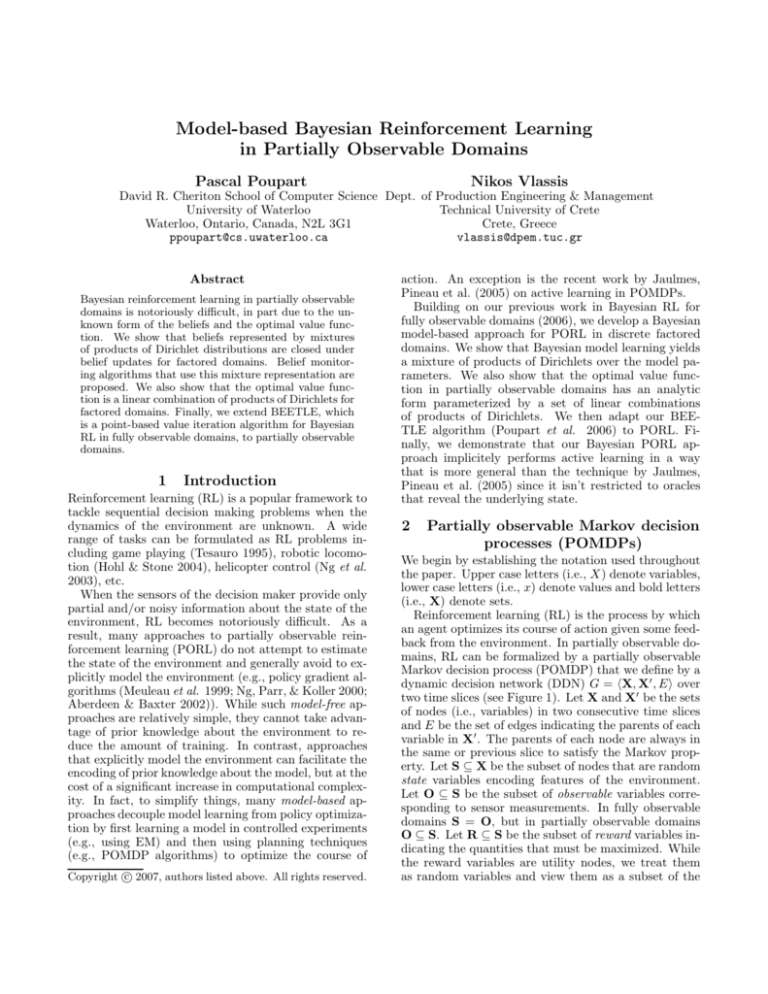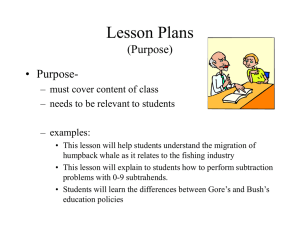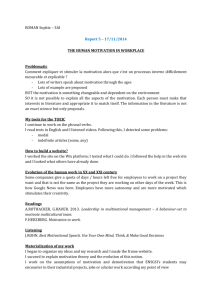
Model-based Bayesian Reinforcement Learning
in Partially Observable Domains
Nikos Vlassis
Pascal Poupart
David R. Cheriton School of Computer Science Dept. of Production Engineering & Management
Technical University of Crete
University of Waterloo
Crete, Greece
Waterloo, Ontario, Canada, N2L 3G1
vlassis@dpem.tuc.gr
ppoupart@cs.uwaterloo.ca
Abstract
Bayesian reinforcement learning in partially observable
domains is notoriously difficult, in part due to the unknown form of the beliefs and the optimal value function. We show that beliefs represented by mixtures
of products of Dirichlet distributions are closed under
belief updates for factored domains. Belief monitoring algorithms that use this mixture representation are
proposed. We also show that the optimal value function is a linear combination of products of Dirichlets for
factored domains. Finally, we extend BEETLE, which
is a point-based value iteration algorithm for Bayesian
RL in fully observable domains, to partially observable
domains.
1
Introduction
Reinforcement learning (RL) is a popular framework to
tackle sequential decision making problems when the
dynamics of the environment are unknown. A wide
range of tasks can be formulated as RL problems including game playing (Tesauro 1995), robotic locomotion (Hohl & Stone 2004), helicopter control (Ng et al.
2003), etc.
When the sensors of the decision maker provide only
partial and/or noisy information about the state of the
environment, RL becomes notoriously difficult. As a
result, many approaches to partially observable reinforcement learning (PORL) do not attempt to estimate
the state of the environment and generally avoid to explicitly model the environment (e.g., policy gradient algorithms (Meuleau et al. 1999; Ng, Parr, & Koller 2000;
Aberdeen & Baxter 2002)). While such model-free approaches are relatively simple, they cannot take advantage of prior knowledge about the environment to reduce the amount of training. In contrast, approaches
that explicitly model the environment can facilitate the
encoding of prior knowledge about the model, but at the
cost of a significant increase in computational complexity. In fact, to simplify things, many model-based approaches decouple model learning from policy optimization by first learning a model in controlled experiments
(e.g., using EM) and then using planning techniques
(e.g., POMDP algorithms) to optimize the course of
c 2007, authors listed above. All rights reserved.
Copyright action. An exception is the recent work by Jaulmes,
Pineau et al. (2005) on active learning in POMDPs.
Building on our previous work in Bayesian RL for
fully observable domains (2006), we develop a Bayesian
model-based approach for PORL in discrete factored
domains. We show that Bayesian model learning yields
a mixture of products of Dirichlets over the model parameters. We also show that the optimal value function in partially observable domains has an analytic
form parameterized by a set of linear combinations
of products of Dirichlets. We then adapt our BEETLE algorithm (Poupart et al. 2006) to PORL. Finally, we demonstrate that our Bayesian PORL approach implicitely performs active learning in a way
that is more general than the technique by Jaulmes,
Pineau et al. (2005) since it isn’t restricted to oracles
that reveal the underlying state.
2
Partially observable Markov decision
processes (POMDPs)
We begin by establishing the notation used throughout
the paper. Upper case letters (i.e., X) denote variables,
lower case letters (i.e., x) denote values and bold letters
(i.e., X) denote sets.
Reinforcement learning (RL) is the process by which
an agent optimizes its course of action given some feedback from the environment. In partially observable domains, RL can be formalized by a partially observable
Markov decision process (POMDP) that we define by a
dynamic decision network (DDN) G = hX, X′ , Ei over
two time slices (see Figure 1). Let X and X′ be the sets
of nodes (i.e., variables) in two consecutive time slices
and E be the set of edges indicating the parents of each
variable in X′ . The parents of each node are always in
the same or previous slice to satisfy the Markov property. Let S ⊆ X be the subset of nodes that are random
state variables encoding features of the environment.
Let O ⊆ S be the subset of observable variables corresponding to sensor measurements. In fully observable
domains S = O, but in partially observable domains
O ⊆ S. Let R ⊆ S be the subset of reward variables indicating the quantities that must be maximized. While
the reward variables are utility nodes, we treat them
as random variables and view them as a subset of the
A
A’
theorem:
ba,o′ (s′ ) = kδ([s′ ]O′ = o′ )
B
B’
C
C’
D
D’
R
R’
Figure 1: Dynamic decision network; set of all variables: X = {A, B, C, D, R}; set of state variables:
S = {B, C, D, R}; observable variables are shaded:
O = {D}; action variables are denoted by squares:
A = {A}; reward variables: R = {R}.
state variables. As we will see shortly, this will be convenient when learning the reward function. Note also
that R is not necessarily a subset of O since rewards
are not generally quantities directly measurable by the
sensors. Let A ⊆ X be the subset of action variables
which are decision nodes. The conditional probability
distributions (CPDs) Pr(S ′ |PAS ′ ) of each state variable S ′ ∈ S′ encode the dynamics of the model. Here
PAX denotes the set of parent variables of X and paX
denotes a joint assignment of values to the set of parent variables of X. Since the observation and reward
variables are subsets of the state variables, the CPDs
of the state variables jointly encode the transition, observation and reward models. The action variables do
not have CPDs since they are decision variables set by
the agent. As we will see shortly, encoding POMDPs as
DDNs offers three advantages: (i) learning the transition, observation and reward models can be done with a
single approach that learns CPDs in general, (ii) prior
knowledge can be encoded in the graphical structure
to reduce the number of CPD parameters that must
be learned and (iii) DDNs are closed under Bayesian
learning of the CPD parameters.
The problem of POMDP planning consists of finding a good policy by controlling the action variables
assuming that X, S, R, O, A are known, the domain
of each variable is known, the edges E are known and
the CPDs are known. A policy consists of a mapping
from histories of observable quantities to actions. Since
observations and actions are the only observable quantities, histories consist of sequences of past actions and
observations. However, histories grow over time, so in
practice it is common to consider policies that are mappings from belief distributions to actions. A belief distribution b(S) = Pr(S) is a fixed-length sufficient statistic
of histories that correspond to the probability distribution over the state variables at the current time step.
Given a belief b(S), we can compute an updated belief
ba,o′ (S′ ) after executing a and observing o′ using Bayes’
X
b(s) Pr(s′ |s, a)
(1)
s
Here k is a normalization constant, [s′ ]O′ is the subset
of state values corresponding to the observable variables
O′ and δ(p) is a kronecker delta that returns 1 when p
is true and 0 otherwise.
The goal is to find a policy π : B → dom(A) that
maximizes the expected total return. More precisely,
the value V π of a policy π starting with belief b is measured by the sum of future discounted rewards:
X
V π (b) =
(2)
γ t Eπ [Ebt [R]]
t
Here, P
γ is a discount factor in [0, 1), Ebt [R] =
P
expected reR∈R
r∈dom(R) bt (r)r is the immediateP
ward according to belief bt , and Eπ [·] = bt Pr(bt |π)·
is the expected value earned at time step t under policy
π. A policy π ∗ is optimal when its value function V ∗ is
at least as high as any other policy for all beliefs (i.e.,
V ∗ (b) ≥ V π (b) ∀π, b). The optimal value function also
satisfies Bellman’s equation:
X
V ∗ (b) = max Eb [R] + γ
Pr(o′ |b, a)V (ba,o′ ) (3)
a
o′
where Pr(o |b, a) = s b(s) Pr(o′ |s, a). Value iteration
algorithms optimize the value function by iteratively
computing the right hand side of Bellman’s equation.
Alternatively, policy search algorithms directly optimize a policy.
′
3
P
Partially observable reinforcement
learning (PORL)
In many real-world problems, the dynamics of the environment encoded by the CPDs may not be known. We
consider the more general problem of PORL in which
we seek to optimize a policy given that X, S, R, O,
A are known, their domain is known and finite, the
edges E are known, but the CPDs are (partially or
completely) unknown.1 We develop a Bayesian modelbased approach to PORL. Section 3.1 describes how to
learn the model in a Bayesian way, while Section 3.2
characterizes the optimal value function.
3.1
Bayesian model learning
As the agent interacts with the environment, it gathers
observations that can be used to construct a model. In
Bayesian learning, this process is achieved by modeling each unknown CPD parameter by a random variable. We start with a prior belief over the model variables, which is subsequently updated after each actionobservation pair. More precisely, for each unknown conditional probability Pr(s′ |paS ′ ), we create a new model
1
The more general problem of structure learning when
the edges E and the state variables S are unknown is subject
to future work.
variable Θs′ |paS′ that can take any value θs′ |paS′ =
Pr(s′ |paS ′ ). Here Θ is a random variable and θ ∈
dom(Θ) = [0, 1] is any probability value. We also denote by ΘS ′ |paS′ the set of all Θs′ |paS′ random variables
for each s′ ∈ dom(S ′ ). Similarly ΘS ′ |PAS′ is the set of
all Θs′ |paS′ for each (s′ , paS ′ ) ∈ dom(S ′ ) × dom(PAS ′ )
and Θ is the set of all ΘS ′ |PAS′ for each S ′ ∈ S′ .
We can then augment the DDN representation of a
POMDP with model variables in such a way that each
conditional distribution is now conditioned on Θ (i.e.,
P r(S ′ |PAS ′ , Θ) = ΘS ′ |PAS′ ). Augmenting the DDN
in Figure 1 with Θ yields the DDN in Figure 2. Assuming that the unknown model is static, the model
variables do not change over time (i.e., Pr(Θ′ |Θ) = 1
when Θ = Θ′ and 0 otherwise).2 It is interesting to
note that the CPDs of the augmented DDN in Figure 2
do not have unknown parameters, which allows us to
compute the joint belief over S and Θ by inference at
each time step. In fact, model learning can be viewed
as belief updating based on each action-observation pair
at each time step. Similar to Equation 1, we can update
joint beliefs as follows:
A
A’
B
B’
C
C’
D
D’
R
R’
Θ
Θ’
Figure 2: Dynamic decision network augmented with
model variables Θ.
ture of products of Dirichlets:
X
ba,o′ (s′ , θ) = kδ([s′ ]O′ = o′ )
Pr(s′ |s, a, θ)b(s, θ)
s
ba,o′ (s′ , θ) = kδ([s′ ]O′ = o′ )
X
b(s, θ) Pr(s′ |s, a, θ)
s
(4)
Despite the fact that Θ is a set of continuous model
variables, belief updates can be done in closed form
when starting with a mixture of Dirichlet distributions
as the prior (Heckerman 1999). Dirichlet distributions
are a class of density functions over the space of discrete probability distributions of the form D(Θ; n) =
kΠi Θini −1 . They are parameterized by a set n of nonnegative hyperparameters n such that each ni can be
interpreted as having observed the Θi -probability event
ni −1 times. Dirichlets distributions have the nice property that they are conjugate priors of multinomial distributions, which means that updating a Dirichlet prior
according to a multinomial sample yields a Dirichlet
posterior. In our case, observations are samples of mixtures of products of multinomial so mixtures of products of Dirichlets are conjugate priors.
= kδ([s′ ]O′ = o′ )
XY
[ θ[s′ |s,a]S′ |PA ′ ]
s
X
i
ci,s
Y
S
S′
Di,s (θS ′ |paS′ ; nS ′ |paS′ )
S ′ ,paS ′
= kδ([s′ ]O′ = o′ )
X
ci,s
Y
S ′ ,paS ′
i,s
Di,s (θS ′ |paS′ ; nS ′ |paS′ + δ(S ′ |paS ′ = [s′ |s, a]S ′ |PAS′ ))
If we use a new index j for each (i, s)-pair, we can
define cj,s′ = kδ([s′ ]O′ = o′ )ci,s and Dj,s′ (θS ′ |paS′ ) =
Di,s (θS ′ |paS′ ; nS ′ |paS′ + δ(S ′ |paS ′ = [s′ |s, a]S ′ |PAS′ )),
making it clear that the posterior is also a mixture of
products of Dirichlets:
Y
X
cj,s′
Dj,s′ (θS ′ |paS′ ) (5)
ba,o′ (s′ , θ) =
j
S ′ ,paS ′
◭
Theorem 1 Mixtures of products of Dirichlets are
closed under belief updates.
Proof: Let the priorPbelief Q
be a mixture of products of
Dirichlets b(s, θ) = i ci,s S ′ ,paS′ Di,s (θS ′ |paS′ ) with
coefficients ci,s , then the posterior belief is again a mix-
2
Learning dynamic models is left as future work.
Note however that the number of components in the
Dirichlet mixtures grows by a factor equal to the size
of the state space at each time step (i.e., exponential
growth with time). Hence, we consider several approximation in Section 4.2 to keep the number of components
bounded.
Bayesian learning of CPDs is closed under DDNs
since inference over Θ essentially learns the CPD parameters of the DDN in Figure 1. Since the CPD parameters encode transition, observation and reward distributions, the entire model is learnt simultaneously by
repeatedly computing the posterior after each actionobservation pair.
3.2
Value Function Parameterization
We now explain how optimal policies and value functions can be derived. Recall that Bayesian PORL can
be modeled as a dynamic decision network (DDN) with
hidden model variables Θ. Conditioning each state variable on the model variables has the effect of completely
determining the conditional probability distribution of
each variable in the network (i.e., Pr(S|PAS , Θ) =
ΘS|PAS ). This important fact means that a POMDP
with unknown dynamics can always be transformed
in a larger POMDP with known dynamics where the
unknown parameters of the original POMDP simply
become hidden variables of the larger POMDP. This
equivalence is quite significant since it implies that existing POMDP planning techniques can be used to optimize the policy of Bayesian PORL problems. However, the added model variables are continuous, which
means that the augmented POMDP is hybrid (discrete state variables with continuous model variables).
Since most POMDP planning techniques cater to discrete POMDPs, Jaulmes, Pineau et al. (2005) considered discretizing the model variables. However, the
resulting number of discrete models grows exponentially with the number of model variables. Alternatively, various sampling approaches have been proposed
to optimize the policy of general continuous POMDPs
by forward search (Ng & Jordan 2000; Kearns, Mansour, & Ng 2002). In particular, several sampling approaches have been tailored to Bayesian reinforcement
problems in fully observable domains (Dearden, Friedman, & Andre 1999; Strens 2000; Wang et al. 2005;
Castro & Precup 2007). However, these approaches
have yet to be generalized to partially observable domains and since the sample complexity grows exponentially with the search horizon, they can only perform a
myopic search in practice.
In another line of research, Porta, Vlassis et al. (2006)
adapted point-based value iteration techniques to general continuous POMDPs. Furthermore, the authors
devised a point-based algorithm called BEETLE for
Bayesian reinforcement learning in fully observable domains (Poupart et al. 2006). The BEETLE algorithm
takes advantage of the fact that the optimal value function has a simple parameterization corresponding to the
upper surface of a set of α-functions each corresponding to a multivariate polynomial. In the rest of this
section, we show that the value function for partially
observable domains is also parameterized by a set of
multivariate polynomials and furthermore, that these
polynomials are linear combinations of Dirichlets. In
the next section, we extend the BEETLE algorithm to
partially observable domains.
Recall that the optimal value function V ∗ of a
POMDP satisfies Bellman’s equation (Eq. 3) and is a
function of b. In the case of Bayesian PORL, beliefs
are mixtures of Dirichlets, hence it is natural to think
of V as a function of the mixture coefficients and the
hyperparameters of the Dirichlets. Unfortunately, this
parameterization generally leads to a non-convex non-
linear value function, which is difficult to work with.
Alternatively, we can also think of V as a function of
the probability of every state-model pair. While this
may not seem like a good idea since there are infinitely
many possible state-model pairs, the value function becomes piecewise linear and convex.
Smallwood and Sondik (1973) first showed the piecewise linear and convex properties of the optimal value
function for discrete POMDPs. More precisely, the optimal value function can always be represented by the
upper surface of a (possibly infinite) set Γ of linear segments called α-vectors (i.e., V ∗ (b) = max α(b)). The
linear property stems from the fact that each α is a linear combination of the probability
values assigned by b
P
to each state (i.e., α(b) = s cs b(s)). For discrete state
spaces, there are finitely many states, which allows α
to be represented as a vector of coefficients cs for each
state s (i.e., α(s) = cs ), hence the name α-vector.
The piecewise linear and convex properties of optimal
value functions was also shown for Bayesian reinforcement learning in fully observable domains (Duff 2002)
and general continuous POMDPs (Porta et al. 2006).
Similar to the discrete case, the optimal value function
is the upper envelope of a (possibly infinite) set Γ of linear functionals called α-functions. The linear property
stems from the fact that α is an infinitesimal linear combination of the
R density values assigned by b to each s
(i.e., α(b) = s cs b(s)ds). Hence α can be represented as
a function that returns the coefficient cs for each state
s of the continuous state space. The authors further
showed that α-functions are multivariate polynomials
in Θ for Bayesian reinforcement learning problems in
fully observable domains (Poupart et al. 2006). Before
showing that this is also the case in partially observable
domains, let’s review the construction of α-functions.
Suppose that the optimal value function V k (b) for k
steps-to-go is composed of a set Γk of α-functions such
that V k (b) = maxα∈Γk α(b). Using Bellman’s equation,
we can compute the set Γk+1 representing the optimal
value function V k+1 with k + 1 stages-to-go. First, we
rewrite Bellman’s equation (Eq. 3) by substituting V k
for the maximum over the α-functions in Γk :
X
V k+1 (b) = max Eb [R] + γ
Pr(o′ |b, a) max α(ba,o′ )
a
o′
α∈Γk
Then we decompose Bellman’s equation in 3 steps. The
first step (Eq. 6) finds the maximal α-function for each
a and o′ . The second step (Eq. 7) finds the best action.
The third step (Eq. 8) performs the actual Bellman
backup using the maximal action and α-functions.
αb,a,o′ = argmax α(ba,o′ )
(6)
α∈Γk
ab = argmax
a
X
Pr(o′ |b, a)αb,a,o′ (ba,o′ )
(7)
o′
V k+1 (b) = Eb [R] + γ
X
Pr(o′ |b, ab )αb,ab ,o′ (bab ,o′ )
o′
(8)
We can further rewrite the third step (Eq. 8) by using α-functions in terms of s and θ (instead of b) and
expanding belief bab ,o′ :
X
V k+1 (b) = Eb [R] + γ
Pr(o′ |b, ab )
o′
XZ
s′
=
XZ
θ
s
bab ,o′ (s′ , θ)αb,ab ,o′ (s′ , θ)dθ
θ
+γ
X
b(s, θ)
[s]R
R
X
s′
′
Pr(s |s, θ, ab )αb,ab ,[s′ ]O′ (s′ , θ) dθ
Since the expression in the square brackets is a function
of s and θ, let’s use it as the definition of an α-function
in Γk+1 :
X
X
αb (s, θ) =
[s]R + γ
Pr(s′ |s, θ, ab )αb,ab ,[s′ ]O′ (s′ , θ)
s′
R
(9)
Hence for every b we can define such an α-function and
together they form the set Γk+1 . Since each αb was
defined by using the optimal action and α-functions in
Γk , then each αb is necessarily optimal at b and we can
introduce a max over all α-functions without changing
anything:
XZ
V k+1 (b) =
b(s, θ)αb (s, θ)dθ
(10)
s
(11)
(12)
α∈Γk+1
We are now ready to demonstrate that α functions
are linear combinations of products of Dirichlets, which
are a special class of multivariate polynomials.
Theorem 2 α-functions are multivariate polynomials
corresponding to linear combinations of products of
Dirichlets in partially observable Bayesian RL.
Proof: We give a proof by induction. Initially, Γ0 consists of a single α-function that assigns 0 to all beliefs.
This α-function is a trivial linear combination of Dirichlets. Assuming that α-functions in Γk are linear combinations of products of Dirichlets, we show that αb in
Eq. 9 is also a linear combination of products of Dirichlets.
Dropping the subscript b in Eq. 9 for simplicity, we
can factor Pr(s′ |s, θ, a) into a product of conditional
distributions, each corresponding
to a model parameter
Q
(i.e., Pr(s′ |s, θ, a) = S ′ θ[s′ |s,a]S′ |PA ′ ). Furthermore,
S
Q
P
let αb,a,[s′ ]O′ (s′ , θ) = i ci,s′ S ′ ,paS′ Di,s′ (θS ′ |paS′ ) be
a linear combination of products of Dirichlets, then
Eq. 9 reads:
X
XY
α(s, θ) =
[s]R + γ
[ θ[s′ |s,a]S′ |PA ′ ]
s′
R
i
ci,s′
R
Y
Y
S ′ ,paS ′
S′
Di,s′ (θS ′ |paS′ )
S
s′ ,i
D(θS ′ |paS′ ; nS ′ |paS′ + δ(S ′ |paS ′ = [s′ |s, a]S ′ |PAS′ ))
S ′ ,paS ′
(14)
◭
Note however that the number of products of Dirichlets in the linear combination increases by a factor
equal to the size of the state space with each Bellman
backup. Hence the size of the linear combinations of the
α-functions increases exponentially with the planning
horizon. We explain several approaches to circumvent
this exponential blow up in Section 4.1.
θ
= αb (b)
= max α(b)
X
Since the rewards [s]R are constant, they can be rewritten as scaled uniform Dirichlets. The uniform Dirichlet
D(θ; e) is a constant function in θ with all hyperparameters set to 1 (denoted by e). Hence, we can replace
[s]R by cR D(θ; e) where cR is a scaling factor. Furthermore, each θ[s′ |s,a]S′ |PA ′ can be absorbed by some
S
Dirichlet by incrementing one of its hyperparameters
(i.e., θ[s′ |s,a]S′ |PA ′ D(θS ′ |paS′ ) = D(θS ′ |paS′ ; nS ′ |paS′ +
S
δ(S ′ |paS ′ = [s′ |s, a]S ′ |PAS′ ))). Performing the substitutions clearly shows that α is a linear combination of
products of Dirichlets:
X
X
α(s, θ) =
cR D(θ; e) + γ
c′i,s′
(13)
4
Partially Observable BEETLE
The following sections explain how to extend the BEETLE algorithm to partially observable domains and how
to execute the resulting policy.
4.1
Policy Optimization
BEETLE is a point-based value iteration algorithm
adapted to Bayesian reinforcement learning in fully observable domains. It finds an approximately optimal
value function represented by a set of α-functions, each
represented by a linear combination of Dirichlets. Since
the optimal value function in partially observable domains has the same form, we propose a straightforward
extend BEETLE, called PO-BEETLE, for partially observable domains. The pseudocode of PO-BEETLE is
given in Algorithm 1. It performs point-based Bellman
backups by constructing the best αb at each belief b ∈ B
by following Equations 6, 7 and 9. The construction of
the belief set B and the termination condition are left
unspecified to let practictioners make their own choice
given the numerous schemes in the point-based value iteration literature. Since the size of each α-function (i.e.,
number of Dirichlet components in the linear combination) may grow by a factor as large as the size of the
state space, a different representation must be used or
the number of components must be reduced to prevent
an exponential blow up.
Although the number of components in α-functions
grows exponentially with the number of Bellman backups, α-functions admit a functional composition that
Algorithm 1 PO-BEETLE
Let B be a set of reachable beliefs
Γ0 ← {0} and i ← 0
repeat
i←i+1
Γi ← ∅
for all b ∈ B do
1. Find best α in Γi−1 for each a, o (Eq. 6)
2. Find best action ab according to Eq. 7
3. Compute αb according to Eq. 9
4. Optional: αb ← reduce(αb )
5. Γi ← Γi ∪ {(αb , ab )}
end for
until some termination condition
has a linear representation with respect to the number of Bellman backups. Since α-functions are computed recursively with Eq. 9, we can simply store how
to obtain αb from each αb,ab ,o′ at the previous iteration.
In other words, αb is obtained by applying some functional composition of the α-functions at the previous
iteration. So, we just need to store the functional composition. Do do this, consider the policy graph induced
by the construction of the α-functions at each Bellman
backup. More precisely, think of each α-function as
a node with its associated action, which is the action
found in Step 2 of Algorithm 1. Draw an edge for each
observation to the node of the best α-function found at
Step 1 of Algorithm 1. Hence, at the node of α, we can
store the reward term Eb [R] used to compute α and for
each edge from α to αa,o we can store the probability
terms θ[s′ |s,a]S′|PA ′ that multiply αa,o . Given such a
S
policy graph, we have all the information necessary to
reconstruct the linear combination corresponding to the
α-function of a node.
Hence, instead of storing exponentially large linear
combinations for each α-function, we can simply store
a policy graph that is linear in the planning horizon.
However, this representation may not be as convenient
for operations on α-functions. However, there is only
one operation performed on α-functions: the evaluation
of a belief (i.e., α(b)). In the case of degenerate beliefs
with probability 1 for some (s, θ)-pair, the evaluation
can be done efficiently in linear time with respect to
the size of the policy graph. The idea is to perform dynamic programming by computing the value of each αfunction at the given θ for each possible state, starting
from the end of the policy graph. In contrast, the evaluation of proper beliefs is not P
as simple
since it is done
R
by integrating over θ: α(b) = s θ α(s, θ)dθ. However
we can always approximate the integral by sampling a
set of (s, θ)-pairs and efficiently computing α(s, θ) with
the above dynamic programming scheme.
Alternatively, we can reduce the number of Dirichlet components in a linear combination with a direct
approximation. One possibility is the projection technique that we proposed in (Poupart et al. 2006), which
is repeated in Algorithm 2 for convenience. The idea is
to find the best linear combination of a fixed set of basis functions φi (θ) that approximates the original linear
combination by minimizing some Ln norm:
Z
X
ci φi (θ)|n dθ
min |α(θ) −
{ci }
θ
i
If we use the Euclidean norm, the coefficients ci can
be found analytically by solving a linear system as described in Algorithm 2.
Algorithm 2 Reduce(least-square-projection)
1. Let µ(θ) be a linear combination of Dirichlets
2. Let φi (θ) be basisR functions (1 ≤ i ≤ k)
3. Compute Ai,j =
R θ φi (θ)φj (θ)dθ for all i, j
4. Compute di = θ φi (θ)µ(θ)dθ for all i
5. Solve Ac = d P
6. Return µ̃(θ) = i ci φi (θ)
Another possibility is to retain only the most important Dirichlet components as measured by the absolute
value of their coefficients. This is analog to performing
a beam search. Algorithm 3 describes the approach.
Algorithm 3 Reduce(deterministic-beam)
P
1. Let µ(θ) = i ci Di (θ) be a linear combination of
Dirichlets
2. Let ci1 to cik be the k largest coefficients in absolute value
Pk
3. Return µ̃(θ) = j=1 cij Dij (θ)
4.2
Policy Execution
Once a policy is optimized offline by computing a set
Γ of (α, a)-pairs with PO-BEETLE, its execution consists of repeatedly updating the belief and executing
the action associated with the best α-function in Γ.
Algorithm 4 describes the pseudocode of policy execution. Note that since the policy has already been optimized by PO-BEETLE, action selection is relatively
light-weight. Nevertheless, updating the belief can become intractable since beliefs are mixtures of Dirichlets that grow exponentially with time. Similar to αfunctions, one must consider a different representation
or some approximation to avoid the exponential blow
up.
We can represent beliefs with a functional composition that grows linearly with time similar to the one for
α-functions. However, unlike value iteration which usually includes less than 100 steps, belief monitoring may
be performed for millions of steps in some applications.
Hence beliefs that grow linearly with time are impractical. As for the projection technique of Algorithm 2,
it doesn’t guarantee that the resulting approximate beliefs are positive in every (s, θ)-pair.
Algorithm 4 Policy execution
Let b be the initial belief
Let Γ be a set of (α, a)-pairs
loop
1. Find best α in Γ for b
2. Execute action a associated with best α
3. Receive observation o′
4. Update belief: compute ba,o′ (Eq. 4)
5. Optional: b ← reduce(b)
end loop
The beam search technique of Algorithm 3 can be
applied to belief updating. In fact, it is expected to
perform quite well since there is only one underlying
model, which can be represented by a single Dirichlet
with infinitely large hyperparameters. As learning progresses, the belief will converge to the underlying model.
Hence, with time, a decreasing number of Dirichlets
components are expected to dominate. So dropping
the least significant Dirichlet components should not
hurt in the long run. However, if the Dirichlets components near the underlying model have small coefficients
initially, they will systematically get pruned and the
learning process may slow down or get stuck. To ensure
asymptotic convergence, we propose a stochastic beam
search which samples Dirichlets components according
to their mixture coefficients. Algorithm 5 describes the
approach.
Algorithm 5 Reduce(stochastic-beam)
P
1. Let µ(θ) = i ci Di (θ) be a mixture of Dirichlets
2. Sample k Dirichlets Dj from the mixture
Pk
3. Return µ̃(θ) = j=1 Dj (θ)
Stochastic beam search is reminiscent of particle filtering. Hence we also consider particle filtering. The
idea is to think of each Dirichlet component as a particle with a corresponding mixture probability. So, instead of generating all the Dirichlet components of a
belief and pruning them by sampling with a stochastic
beam, we directly sample the components to be generated. Hence particle filtering is faster than stochastic beam, yet equivalent. Algorithm 6 describes the
pseudocode of particle filtering with Dirichlets particles. Note that particle filtering with (s, θ)-particles is
not possible since there are no transition dynamics for
θ.
5 Active Learning and the
Exploration/Exploitation Tradeoff
Active learning occurs when the learner can influence
the selection of the data from which it learns. In reinforcement learning, it is natural for the learner to
be active since the action selected influences the states
that will be reached in the future and therefore, the information that will be gained. An important problem
Algorithm 6 Particle filtering
P
Let b(s, θ) = i ci,s Di,s (θ) be the current belief
Let a be the action selected
Let o the observation received
j←0
while j < k do
1. Sample (i, s)-pair according to mixture coefficients ci,s
2. Sample θ from Di,s (θ)
3. Sample s′ from Pr(s′ |s, θ, a)
if s′ is consistent with o′ then
4. j ← j + 1
5. Dj,s′ (θ) ← Di,s (θ; n + 1s,a,s′ )
end if
end while
P
Return b̃a,o′ (s′ , θ) = 1/k kj=1 Dj,s′ (θ)
of active learning is how to select actions effectively
to maximize some objective, which is the sum of expected total rewards in reinforcement learning. This
leads to the exploration/exploitation tradeoff where by
the learner is tempted to select actions that exploit its
knowledge to maximize immediate return and to select
actions that explore to gain additional information to
maximize future returns.
The POMDP formulation of Bayesian reinforcement
learning provides a natural framework to reason about
the exploration/exploitation tradeoff. Since beliefs encode all the information gained by the learner and an
optimal POMDP policy is a mapping from beliefs to
actions that maximizes expected total rewards (which
include the immediate rewards seeked by exploitation
and the future rewards seeked by exploration), it follows
that an optimal POMDP policy naturally optimizes the
exploration/exploitation tradeoff.
Jaulmes, Pineau et al. (2005) recently considered active learning in partially observable domains, but information gathering actions were restricted to oracles that
reveal exactly the underlying state. This restriction was
due to the use of a model learning approach that requires full observability of the state space. In contrast,
we describe a general and principled approach to optimize active learning that does not restrict in any way
the type of actions. As demonstrated in Theorem 1,
belief updates with partially observable actions simply
lead to mixtures of products of Dirichlets.
6
Conclusion and Future Work
In summary, this paper showed that beliefs and value
functions can be analytically represented by a mixtures
of Dirichlets and linear combinations of Dirichlets respectively. This represents an important contribution
to the theory of Bayesian reinforcement learning in partially observable domains. General and principled techniques were proposed to update beliefs and optimize
policies by exploiting their respective analytical form.
We are currently implementing and testing the pro-
posed algorithms and hope to report empirical results
in the near future. This work could be further extended
by considering the problem of structure learning (i.e.,
learning the graphical structure of the dynamic decision
network), considering continuous states, actions and observations and considering non-stationary models.
References
Aberdeen, D., and Baxter, J. 2002. Scaling internalstate policy-gradient methods for POMDPs. In ICML,
3–10.
Castro, P. S., and Precup, D. 2007. Using linear programming for Bayesian exploration in Markov decision
processes. In IJCAI, 2437–2442.
Dearden, R.; Friedman, N.; and Andre, D. 1999.
Model based Bayesian exploration. In UAI, 150–159.
Duff, M. 2002. Optimal Learning: Computational procedures for Bayes-adaptive Markov decision processes.
Ph.D. Dissertation, University of Massassachusetts
Amherst.
Heckerman, D. 1999. A tutorial on learning with
bayesian networks. In Jordan, M., ed., Learning in
Graphical Models. Cambridge, MA: MIT Press.
Hohl, N., and Stone, P. 2004. Policy gradient reinforcement learning for fast quadrupedal locomotion.
In ICRA.
Jaulmes, R.; Pineau, J.; and Precup, D. 2005. Active learning in partially observable Markov decision
processes. In ECML, 601–608.
Kearns, M.; Mansour, Y.; and Ng, A. 2002. A sparse
sampling algorithm for near-optimal planning in large
Markov decision processes. Machine Learning 49:193–
208.
Meuleau, N.; Peshkin, L.; Kim, K.-E.; and Kaelbling,
L. P. 1999. Learning finite-state controllers for partially observable environments. In UAI, 427–436.
Ng, A. Y., and Jordan, M. I. 2000. PEGASUS: a
policy search method for large MDPs and POMDPs.
In UAI, 406–415.
Ng, A.; Kim, H. J.; Jordan, M.; and Sastry, S. 2003.
Autonomous helicopter flight via reinforcement learning. In NIPS.
Ng, A.; Parr, R.; and Koller, D. 2000. Policy search
via density estimation. In NIPS, 1022–1028.
Porta, J. M.; Vlassis, N. A.; Spaaan, M. T. J.; and
Poupart, P. 2006. Point-based value iteration for continuous pomdps. Journal of Machine Learning Research 7:2329–2367.
Poupart, P.; Vlassis, N.; Hoey, J.; and Regan, K. 2006.
An analytic solution to discrete Bayesian reinforcement learning. In ICML, 697–704.
Smallwood, R. D., and Sondik, E. J. 1973. The optimal control of partially observable Markov processes
over a finite horizon. Operations Research 21:1071–
1088.
Strens, M. 2000. A Bayesian framework for reinforcement learning. In ICML, 943–950.
Tesauro, G. J. 1995. Temporal difference learning and
TD-Gammon. Communications of the ACM 38:58–68.
Wang, T.; Lizotte, D.; Bowling, M.; and Schuurmans,
D. 2005. Bayesian sparse sampling for on-line reward
optimization. In ICML, 956–963.








